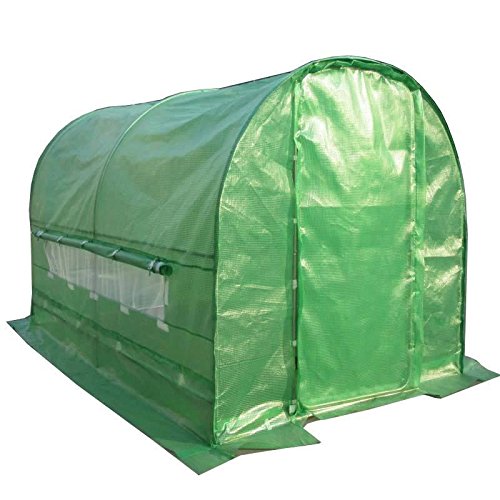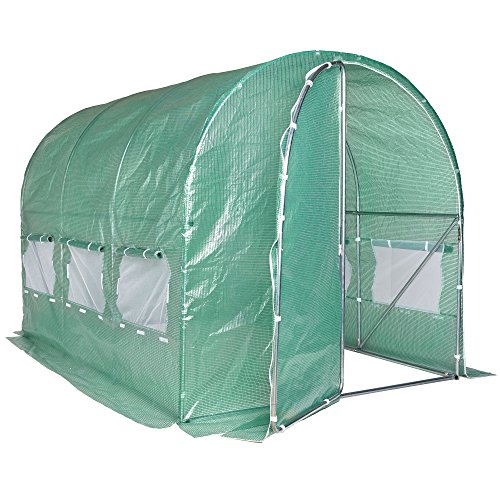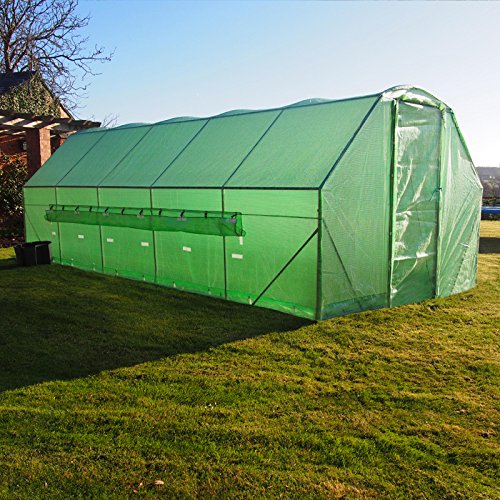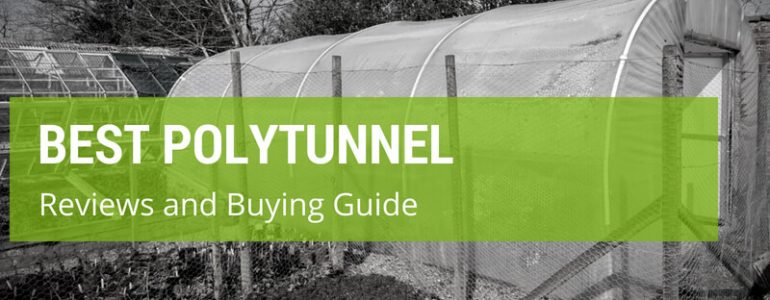So you’re looking to invest in a polytunnel eh? Then you’ve definitely come to the right place. Here, I’ve got all the essential information for newbies and experienced farmers alike, as well as some of the most popular products currently doing rounds in the UK. But first:
What is a Polytunnel?
Also known as hoophouses, polytunnels are extended, polythene covered frames that resemble green houses but are relatively simpler. In essence, these tunnels protect plants from strong winds, heavy rains, hailstones, and other destructive elements.
But since a polytunnel also creates its own microclimate, it allows us to grow all sorts of fruits, vegetables, plants and crops that wouldn’t be normally found in our cold climate. These tunnels come in various shape and sizes for different needs.
Types of Polytunnels
- Regular Tunnels – This is a basic, single span structure that allows for easy installation and maintenance. They’re among the cheapest options and can be found in very small sizes. However, the curved sides can be a headroom issue with excessively small structures
- Solar Tunnels – These offer a standard design with straight sides and a very unique cover. Instead of polythene, solar panels are clad in sections of double layers reinforced with nylon mesh. This allows for more durability but reduces light transmission.
- Panel Houses – This is a hybrid between tunnel and greenhouse. The best models use dual wall construction with embedded bubbles for stronger cladding and insulation. They may have also installed heaters, etc. However, they’re quite expensive.
Key Features and Considerations when Purchasing Polytunnels
i) Plot Size and Location
The first thing you want to consider is whether the polytunnel will fit in the allotted space. For the size, there’s no need to worry since most polytunnel manufacturers make them as compact as under 10 feet long to monstrosities that stretch to over 60 feet. Likewise, a relatively flat plot is ideal as opposed to a hilly, irregular one.
ii) Durable Covers
Some of the best polytunnels have covers so durable that they can comfortably last for almost 20 years. That’s why you want to make sure you get polythene covers with at least a 5 year guarantee.
iii) Simple Construction
Another feature to consider is the ease of construction. You want a polytunnel with clear instructions that are easy to follow. Bigger tunnel will take longer to build, but a smaller model should take you just a couple hours.
iv) Well Ventilated Tunnel
While the main aim of polytunnels is keeping warm air in, the last thing you want is too much heat. The greenhouse effect still applies here, so you’ll want as much ventilation as possible. Vents allow fresh air in to keep the environment optimal for plant growth.
v) Easy to Move
Years of planting and harvesting on the same plot could not only diminish nutrients, but also cause a build up of diseases. That’s why you want a tunnel that moves around easily so you can use a different section of your land.
vi) Multifunctionality
You want a tunnel that doesn’t limit you to just a single gardening job. Some polytunnels come with the ability to install potting benches, shelves for drying bulbs and herbs as well as evacuation for covering outdoor pools or drying laundry.
Best Polytunnel Reviews
1. BEST FOR ALLOTMENT: FeelGoodUK Allotment Polytunnel

If there’s one company that’s been really making titanic leaps in the gardening industry, it’s got to be FeelGoodUK. And true to its name, it’s been making gardeners all over the UK feel great. Statistics show that more and more people are renting pieces of land exclusively for flowers and veggies due to the success of polytunnels. If you’re looking for something hardy that can be used for allotment, your search ends right here.
The FeelGoodUK Polytunnel comes with a full, heavy duty 25mm steel metal frame and stronger welded joints all through. This gives it one of the most robust frameworks on this list capable of withstanding fairly harsh winds and rains. But it’s the cover that really stands out. The manufacturer made use of durable UPVC covers that not only keep the heat inside, but protect your plants from strong winds and snow. It’s also easy to assemble and the best part is, it comes with a real door – no more weak roll ups and zippers.
What I like about it:
- Ideal for allotment
- Robust, fully galvanised non rust steel frame
- Opening door
2. BEST VALUE: VonHaus Walk In Polytunnel

Whether professionally or as a hobby, we’ve all dreamed of being able to grow our favourite fruits and veggies way past their growing season. However, the costs involved in purchasing a greenhouse often put many potential gardeners off. If you’re looking for a solid alternative to those bulky, expensive traditional greenhouses, then the VonHaus Walk In Polytunnel guarantees the best value for your money.
With its spacious, 6 square metres of walk in space, this polytunnel offers gardeners more than enough room for trays, pots, grow bags, shelving, and pretty much any other farming equipment you can fit in there. The heavy duty PE covers come with extra long sides for more anchoring and support during harsh conditions and while fully closed, the tunnel traps heat and maintains optimum humidity levels. It also features a metal frame and door for easy access. For ventilation, the manufacturer included six roll up mesh windows that are insect proofed. This makes it a value added option for allotments and family gardens.
What I like about it:
- Heavy duty, durable PE synthetic covers
- Spacious room for plenty of crops and shelves
- Extra long sides for extra anchoring
3. BEST SMALL: Harbour Housewares Vegetable Greenhouse
You don’t need to be in business to afford a mini greenhouse. Imagine being able to grow and eat your own tomatoes, fruits and vegetables right in your own backyard! And the best part is, it won’t even cost you a fraction of what you’d spend for some of the other tunnels on the list. Introducing the most popular family tunnel and smallest model on our list, it’s no wonder thousands of homeowners are getting the Harbour Housewares Vegetable Greenhouse.
This baby might just be 196 cm wide and 77 cm deep, but it’s got all the features that you’d find in a high end tunnel. For starters, Harbour Housewares incorporated strong reinforced covers that really do a good job of protecting crops. But just because a tunnel is small doesn’t mean it shouldn’t be well ventilated. Fortunately, the mini greenhouse comes with side ventilation so that you can let some fresh air in. Of course, the windows have mesh so that insects and pest don’t find a way in and wreak havoc on your crops. The square tunnel is a great option if you’re short on cash or just need a nice hobby garden.
What I like about it:
- Most affordable model on the list
- Durable covers with generous ventilation
- Four ground pegs for secure foundation
4. BEST LARGE: FeelGoodUK Galvanised Anti Rust Polytunnel

If you’re looking at this particular model, I’ve got just one question that will set things straight – how serious are you about your farming? If the answer is dead serious, then the FeelGoodUK Galvanised Anti Rust Polytunnel was made just for you. This is the only 6 section polytunnel currently on the UK market and also the largest model in our entire list. This unit is almost like FeelGood’s best model for allotment; the only difference is that this one is super sized.
Measuring in at 6 by 3 by 2 metres, this mammoth tunnel now allows for more room to get things really going. Whether you want to fill a few sections with grow pots and trays and use another for drying your herbs, Anti Rust Polytunnel gives you more than enough room to really start reaping substantial profits from your allotment. But it’s not just the sheer size that sells. The manufacturer used 25mm galvanized steel poles to create the frame and made it anti rust so it can survive for years under high humidity levels. The covers consist of 140g transparent polythene material with UV protection for comprehensive element protection.
What I like about it:
- Largest model with generous space
- Full metal door with bracing and support on both sides
- Controllable environment via cooling and heating systems
5. BEST PREMIUM: KMS FoxHunter Steel Polytunnel

For the learned and experienced farmer, the last thing you want is to spend hours setting up a tunnel only to have all your crops die. So if you’re looking for a polytunnel that us much more than just a frame with covers, then take a gander at one of the best premium models in the UK market. The KMS FoxHunter Steel Polytunnel might just be the closest thing to a functional greenhouse you can get for the price.
This particular premium model comes with all the perks you’d expect from a high end unit including strong, heavy duty steel frames and the classic, long, tough UV protected covers. Granted that the six section tunnel gives gardeners plenty of room to work with, there’s a trade off with the doors which are zipped. However, KMS really focused on the technological aspect of farming for this one. They included a fully controllable environment where you can increase humidity as well as manage the temperature.
What I like about it:
- High quality construction
- Double doors allow for wider entrance
- Protection from temperature extremes
Frequently Asked Questions
Q: How to secure a polytunnel to the ground?
How to stop polytunnel blowing away? Any garden structure will need weighing down so it doesn’t turn into a kite, and polytunnels are no exception. You can use an anchor base, which means that you don’t have to use concrete so secure your polytunnel, or a base plate which holds the polytunnel into a concrete or hard standing area.
Q: What to grow in a polytunnel over the winter?
The beauty of a polytunnel is that it will stay warmer than the surroundings, so you can grow things in the winter that you cannot grow in the exposed garden.
You can grow the standard winter veggies like cabbage, sprouts and brassicas, or you can branch out and plant things like carrots and radishes.
Herbs are another great crop for your polytunnel; go for coriander and basil to add some more flavour to your dinner.
You can also plant over-wintering vegetables like garlic, broad beans and kale to give them the best head start for the growing season.
Q: Why to use a polytunnel?
A polytunnel is a fantastic way to grow vegetables, flowers and herbs that need to stay a little bit warmer. A polytunnel is like a larger version of a greenhouse; it’s a much warmer environment than outside, and it is usually a larger space than a greenhouse so you won’t have to worry about overcrowding.
Another advantage is that you can either plant things straight into the ground or use pots – either way they will benefit from the extra warmth.
Polytunnels are also a great way to fill in the “hungry gap”, which is where overwintering plants have bolted and finished, and before the spring crops are ready – with a polytunnel, you can keep crops going almost year round.
Q: How to clean a polytunnel?
It’s relatively easy to clean a polytunnel, despite its rather daunting size. You can use a pressure washer to blast off any dried on muck on the outside, and you can do the same on the inside too. February is the best time to do this, as the tunnel will likely be at its emptiest around this time. You should also take the time to clean out any dead plants inside the polytunnel.








Don’t purchase garden grow tunnel…spare covers not available
Not very good in windy areas. The bottom trench flaps are not long enough to dig in and pull out in strong wind conditions. I have just scrapped mine after only one year. The frame will be good to use as a fruit cage with netting tho. I am considering going back to a conventional poly tunnel that I had before. It never pulled out in wind but did tear from flying debris. Swings and roundabouts.
Do you know of any supplier that does a small polytunnel? 4 ft x 6 or 8 ft max. Thanks.